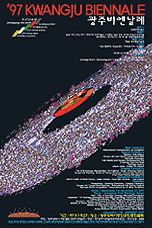2ND GWANGJU BIENNALE 1997
02 Sep - 27 Nov 1997
Unmapping the Earth
1 September – 27 November 1997
Commissioners: Yoo Jun Sang, Harald Szeemann, Park Kyong, Sung Wan Kyung, Bernard Marcade
Aaron H. H. Tan, Alain Séchas, Alberto Breccia, Annette Messager, Apsolutno, Arata Isozaki, Artcamp, Bahc Mo, BEIRUT 2, Ben Vautier, Beom Kim, Bill VIOLA, Bodys Isek Kingelez, Camilo Jose Vergara, Carlos Garaicoa, Cesar Pelli, Chen Zhen, Chris Burden, Chris Marker, Cindy Sherman, David Reeb, Emmanuel Carlier, Erik Boulatov, Ernest Cirangle, Fabrice Hybert, Felix Gonzalez-Torres, Feng Mengbo, Frédéric Bruly Bouabré, Franz Gertsch, Gabriele Kostas, Gabrielle Basilico, Gary Hill, Georgina Starr, Gilbert&George, Greg Girad, Hannes Brunner, Harun Farocki, Hiroji Kubota, Huang Yong ping, Ingeborg Lüscher, Jimmie Durham, Joep van Lieshout, John Cage, John Gollings, Joseph Beuys, Kang Ik-Joong, Kevin Neel, Koo Jeong-A, Leni Riefenstahl, Leonardo da Vinci, Lim Choong-sup, Louise Bourgeois, Luis Camnitzer, Lyndall Jones, Manuel Ocampo, Margaret Morton, Marie Sester, Mariko Mori, Max Neuhaus, Mel Chin and the GALA Committee, Milomir Kovacevic, Mona Hatoum, Navin Rawanchaikul, Nedko Solakov, Niele TORONI, Nigel Rolfe, Osvaldo Romberg, Pascale Martine Tayou, Paul McCarthy, Peter Fischli David Weiss, Pipilotti Rist, Rainer Ganahl, Renée Green, Rhee Ki-bong, Rick Lowe, Rob Schroder, George Brugmans, Rosangela Renno, Rosemarie Trockel, Serge Spitze, Shigeru Ban, Stan Douglas, Stefanie Burkle, Uri Tzaig, Vivan Sundaram, Wim Delvoyer, Wolfgang Laib, Xu Bing, Yung-Ho Chang
Participating Countries : 117 Artists from 39 Countries
Artist : 117
While the visual concept of negative space often manifests itself in a limited manner in Western art, it is almost omnipresent in the East, and is most easily defined as the space that is left around the characters and images in a composition. Despite the connotations of the word “negative” it also holds the implication of possibility, new creation, and new creativity. In a broader sense, it can represent resistance against encroaching modern society and the destruction of the primeval.
The main exhibition was designed to discuss the importance of the flow of the natural in its relationship to negative space to create a dialogue on a harmonious coexistence between the built and the pristine. It was composed of five parts: Speed, Space, Hybrid, Power and Becoming.

